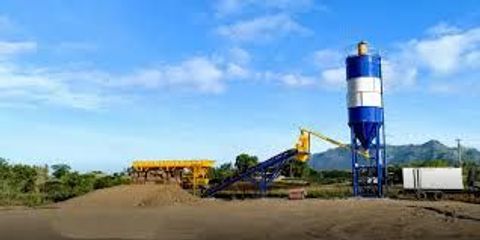Explore Dry Mix Plants: A Complete Guide with Key Facts and Insights
Dry mix plants, also known as dry mix mortar plants, are facilities designed to produce pre-mixed construction materials used for applications such as plastering, tiling, masonry, and repair. Unlike traditional mixing methods that require water at the site, dry mix plants prepare and package the material in a dry form, allowing users to add water only before application.
This innovation has transformed the construction industry by providing consistency, efficiency, and quality control. The concept emerged in response to the need for ready-to-use, high-performance building materials that ensure uniform results across projects.
Modern dry mix plants are equipped with automated systems that measure, blend, and store materials like cement, sand, and additives. These plants serve multiple sectors from residential construction to large-scale infrastructure projects making them an essential component of the building materials supply chain.
Why Dry Mix Plants Matter
The significance of dry mix plants lies in their ability to streamline construction processes. In today’s fast-paced infrastructure development environment, contractors and engineers need reliable, high-quality materials that save time and reduce waste.
Dry mix technology addresses these challenges effectively:
-
Consistency: Each batch has uniform composition and quality.
-
Time Efficiency: Mixing is faster and easier at the application site.
-
Reduced Waste: Materials are pre-measured, minimizing excess.
-
Durability: Enhanced material performance due to precise formulation.
-
Environmental Benefits: Reduced dust, water use, and on-site pollution.
These advantages have made dry mix plants a preferred choice for modern builders, especially in regions experiencing rapid urbanization. According to industry data, the global dry mix mortar market continues to expand, driven by growth in housing, infrastructure, and industrial construction.
Current Trends and Developments
The dry mix industry has evolved significantly over the past few years. In 2024 and 2025, several advancements have reshaped production, automation, and sustainability practices.
Key industry trends include:
-
Automation and AI Integration (2024–2025): Many plants have adopted smart control systems for precise batching and mixing. This reduces human error and ensures consistent product quality.
-
Eco-friendly Formulations: The rise in green construction has led to the development of low-carbon mortars and energy-efficient production processes.
-
Expansion in Emerging Markets: Countries in Asia and the Middle East, including India, China, and the UAE, are witnessing increased investment in dry mix technology to support rapid urban growth.
-
Improved Packaging Solutions: The introduction of moisture-resistant and recyclable packaging has enhanced product longevity.
-
Digital Monitoring and Predictive Maintenance: Advanced sensors and analytics help monitor equipment health, reducing downtime and improving productivity.
A 2025 industry report by Global Construction Insights noted that automated dry mix plants improved production efficiency by up to 30%, marking a major leap in construction technology.
Regulations and Standards
Dry mix production is subject to several regulations that ensure safety, quality, and environmental compliance. Depending on the country, these may vary, but most align with international construction material standards.
Key regulatory areas include:
-
Material Quality Standards: Compliance with ISO and ASTM standards ensures the performance and durability of dry mix products.
-
Environmental Regulations: Many countries enforce limits on dust emissions, energy consumption, and waste management.
-
Health and Safety Laws: Worker protection regulations govern equipment use, ventilation, and dust control in plants.
-
Building Codes and Certification: Products must meet national building codes to be used in certified construction projects.
In India, for instance, dry mix plants often comply with Bureau of Indian Standards (BIS) guidelines and follow environmental norms set by the Central Pollution Control Board (CPCB). Similarly, European plants adhere to EN 998 standards for mortar mixes, ensuring product consistency and performance.
Governments are also promoting eco-friendly construction initiatives. For example, the Indian Green Building Council (IGBC) encourages the use of sustainable materials, indirectly boosting the demand for dry mix mortars that reduce waste and water consumption.
Helpful Tools and Resources
Professionals working with dry mix plants or planning to establish one can benefit from several tools and platforms designed for project management, calculation, and process optimization.
Recommended resources include:
| Category | Tool / Platform | Function |
|---|---|---|
| Design and Calculation | Drymix Calculator | Helps determine proportions for different mortar applications. |
| Automation Systems | Siemens SIMATIC PCS 7 | Used for plant automation, monitoring, and data control. |
| Quality Control | MATLAB for Mix Design Analysis | Analyzes raw material ratios and strength parameters. |
| Learning and Training | Cement.org | Provides educational materials and e-learning courses on mortar technology. |
| Industry Reports | Statista / ResearchAndMarkets | Offers market data, forecasts, and trend analysis. |
| Regulatory Information | BIS / ASTM Websites | Access to current construction material standards. |
These tools can help engineers, plant operators, and researchers enhance production efficiency and compliance. Many of them also support digital integration, allowing real-time process optimization and performance tracking.
Frequently Asked Questions
1. What is the main difference between dry mix and wet mix plants?
Dry mix plants prepare materials without adding water, which is only added at the application site. Wet mix plants, on the other hand, include water in the process, producing ready-to-use concrete or mortar.
2. Are dry mix mortars environmentally friendly?
Yes, most dry mix mortars generate less dust, reduce water use, and support efficient material utilization. Many modern formulations also use eco-friendly additives and recyclable packaging.
3. How is quality maintained in a dry mix plant?
Quality is ensured through automated weighing, consistent mixing ratios, and periodic testing of raw materials. Plants typically follow ISO or EN standards for quality control.
4. Can dry mix plants be customized for different materials?
Absolutely. Depending on project requirements, plants can be configured to produce specific mortars like tile adhesive, plaster, masonry mortar, or floor screed.
5. What is the future outlook for the dry mix industry?
The market is expected to grow steadily as construction companies adopt automation and sustainability practices. Increased government focus on green buildings and infrastructure development is driving further innovation.
Key Insights and Overview
The steady rise of dry mix plants signifies a shift toward automation, quality assurance, and sustainable construction methods. Their adaptability across multiple sectors from housing to heavy infrastructure makes them an essential asset in modern construction.
Industry growth is supported by technological innovation, regulatory compliance, and increased awareness of sustainable practices. Moreover, digitalization and smart plant monitoring are setting new benchmarks for efficiency and safety.
The evolution of dry mix plants is not only about improving material quality but also about advancing how we build more efficiently, responsibly, and sustainably.
Conclusion
Dry mix plants represent a key transformation in the construction material industry, combining efficiency, consistency, and sustainability. As global infrastructure demands continue to rise, their role in shaping modern construction practices becomes even more critical.
From automation to green building initiatives, every development points toward a smarter and more eco-conscious future. Whether you are a civil engineer, project manager, or student, understanding dry mix technology offers valuable insights into the evolving dynamics of modern construction.







